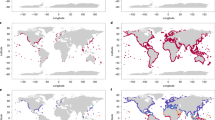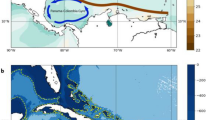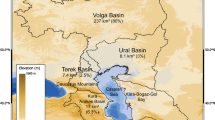Abstract
Sea-level rise (SLR) is a critical and uncertain climate change risk, involving timescales of centuries1. Here we use a semi-empirical model, calibrated with sea-level data of the past millennium2, to estimate the SLR implications of holding warming below 2 °C or 1.5 °C above pre-industrial temperature, as mentioned in the Cancún Agreements3. Limiting warming to these levels with a probability larger than 50% produces 75–80 cm SLR above the year 2000 by 2100. This is 25 cm below a scenario with unmitigated emissions, but 15 cm above a hypothetical scenario reducing global emissions to zero by 2016. The long-term SLR implications of the two warming goals diverge substantially on a multi-century timescale owing to inertia in the climate system and the differences in rates of SLR by 2100 between the scenarios. By 2300 a 1.5 °C scenario could peak sea level at a median estimate of 1.5 m above 2000. The 50% probability scenario for 2 °C warming would see sea level reaching 2.7 m above 2000 and still rising at about double the present-day rate. Halting SLR within a few centuries is likely to be achieved only with the large-scale deployment of CO2 removal efforts, for example, combining large-scale bioenergy systems with carbon capture and storage4.
This is a preview of subscription content, access via your institution
Access options
Subscribe to this journal
Receive 12 print issues and online access
$209.00 per year
only $17.42 per issue
Buy this article
- Purchase on SpringerLink
- Instant access to full article PDF
Prices may be subject to local taxes which are calculated during checkout



Similar content being viewed by others
References
Meehl, G. A. et al. in IPCC Climate Change 2007: The Physical Science Basis (eds Solomon, S. et al.) (Cambridge Univ. Press, 2007).
Kemp, A. C. et al. Climate related sea-level variations over the past two millennia. Proc. Natl Acad. Sci. USA 108, 11017–11022 (2011).
UNFCCC Report of the Conference of the Parties on its Sixteenth Session, held in Cancún from 29 November to 10 December 2010 (UNFCCC, 2011); available via http://unfccc.int/resource/docs/2010/cop16/eng/07a01.pdf.
Van Vuuren, D. & Riahi, K. The relationship between short-term emissions and long-term concentration targets. Climatic Change 104, 793–801 (2011).
German Advisory Council on Global Change The Future Oceans - Warming Up, Rising High, Turning Sour. 110 (Earthscan, 2006).
Meehl, G. A. et al. How much more global warming and sea level rise? Science 07, 1769–1772 (2005).
Deltacommissie Samen werken met water. Een land dat leeft, bouwt aan zijn toekomst (The Netherlands, 2008).
Jevrejeva, S., Moore, J. C. & Grinsted, A. Sea level projections to AD2500 with a new generation of climate change scenarios. Glob. Planet. Change 80-81, 14–20 (2012).
Rahmstorf, S. A Semi-Empirical approach to projecting future sea-level rise. Science 315, 368–370 (2007).
Meinshausen, M., Raper, S. C. B. & Wigley, T. M. L. Emulating coupled atmosphere-ocean and carbon cycle models with a simpler model, MAGICC6. Part 1: Model description and calibration. Atmos. Chem. Phys. 11, 1417–1456 (2011).
Meinshausen, M. et al. Greenhouse-gas emission targets for limiting global warming to 2 °C. Nature 458, 1158–1162 (2009).
Rogelj, J. et al. Analysis of the Copenhagen Accord pledges and its global climatic impacts, a snapshot of dissonant ambitions. Environ. Res. Lett. 5, 034013 (2010).
Vuuren, D. P. et al. The representative concentration pathways: An overview. Climatic Change 31, 5 (2011).
Meinshausen, M. et al. The RCP greenhouse gas concentrations and their extensions from 1765 to 2300. Climatic Change 109, 213–241 (2011).
Thomson, A. et al. RCP4.5: A pathway for stabilization of radiative forcing by 2100. Climatic Change 109, 77–94 (2011).
van Vuuren, D. et al. Stabilizing greenhouse gas concentrations at low levels: An assessment of reduction strategies and costs. Climatic Change 81, 119–159 (2007).
Meinshausen, M. et al. Multi-gas emissions pathways to meet climate targets. Climatic Change 75, 151–194 (2006).
Magné, B., Kypreos, S. & Turton, H. Technology options for low stabilization pathways with MERGE. Energy J. 31, 83–107 (2010).
Knopf, B. et al. Managing the Low-Carbon Transition — From Model Results to Policies. Energy J. 31, 223–245 (2010).
Azar, C. et al. The feasibility of low CO2 concentration targets and the role of bio-energy with carbon capture and storage (BECCS). Climatic Change 100, 195–202 (2010).
Hare, B. & Meinshausen, M. How much warming are we committed to and how much can be avoided? Climatic Change 75, 111–149 (2006).
Church, J. A. & White, N. J. A 20th century acceleration in global sea-level rise. Geophys. Res. Lett. 33, L01602 (2006).
Cazenave, A. & Llovel, W. Contemporary sea level rise. Annu. Rev. Marine Sci. 2, 145–173 (2010).
Vermeer, M. & Rahmstorf, S. Global sea level linked to global temperature. Proc. Natl Acad. Sci. USA 106, 21527–21532 (2009).
Rahmstorf, S., Perrette, M. & Vermeer, M. Testing the robustness of semi-empirical sea level projections. Clim. Dynam. http://dx.doi.org/10.1007/s00382-011-1226-7(2011).
Grinsted, A., Moore, J. & Jevrejeva, S. Reconstructing sea level from paleo and projected temperatures 200 to 2100. Clim. Dynam. 34, 461–472 (2010).
Jevrejeva, S., Moore, J. C. & Grinsted, A. How will sea level respond to changes in natural and anthropogenic forcings by 2100? Geophys. Res. Lett. 37, L07703 (2010).
Mann, M. E. et al. Proxy-based reconstructions of hemispheric and global surface temperature variations over the past two millennia. Proc. Natl Acad. Sci. USA 105, 13252–13257 (2008).
Jevrejeva, S., Grinsted, A., Moore, J. C. & Holgate, S. Nonlinear trends and multiyear cycles in sea level records. J. Geophys. Res. 111, C09012 (2006).
Acknowledgements
We thank M. Meinshausen for providing the Monte-Carlo methodology and tools for the climate-model simulations, as well as the adjusted RCP scenario RCP4.5 to 3PD. We thank H. Turton for advising on the application of the MERGE scenario and for kindly providing us with gas-specific emissions data.
Author information
Authors and Affiliations
Contributions
M.S. jointly conceived the study with W.H., S.R. and M.V., designed and carried out simulations, developed the methodology, analysed data and wrote the paper with W.H., S.R. and M.V. W.H. conceptualized and selected scenarios with M.S. S.R. and M.V. advised on methodology and statistical analysis.
Corresponding author
Ethics declarations
Competing interests
The authors declare no competing financial interests.
Supplementary information
Rights and permissions
About this article
Cite this article
Schaeffer, M., Hare, W., Rahmstorf, S. et al. Long-term sea-level rise implied by 1.5 °C and 2 °C warming levels. Nature Clim Change 2, 867–870 (2012). https://doi.org/10.1038/nclimate1584
Received:
Accepted:
Published:
Issue Date:
DOI: https://doi.org/10.1038/nclimate1584
This article is cited by
-
China’s carbon neutrality: an extensive and profound systemic reform
Frontiers of Environmental Science & Engineering (2023)
-
A global analysis of subsidence, relative sea-level change and coastal flood exposure
Nature Climate Change (2021)
-
The Impact of Sea Level Rise Due to Global Warming on the Coastal Population Dynamics: A Modeling Study
Earth Systems and Environment (2021)
-
Surface Temperature Changes Projected by FGOALS Models under Low Warming Scenarios in CMIP5 and CMIP6
Advances in Atmospheric Sciences (2021)
-
Projected precipitation changes over China for global warming levels at 1.5 °C and 2 °C in an ensemble of regional climate simulations: impact of bias correction methods
Climatic Change (2020)



